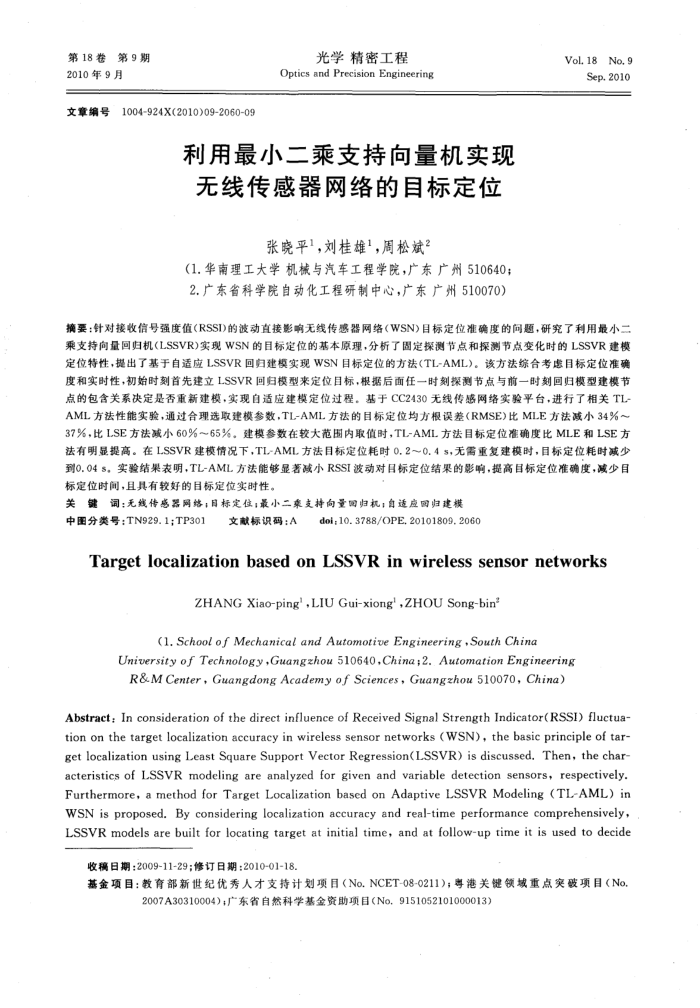利用最小二乘支持向量机实现无线传感器网络的目标定位
内容简介
 第18卷第9期 2010年9月
第18卷第9期 2010年9月1004-924X(2010)09-206009
文章编号
光学精密工程
Optics and Precision Engineering
利用最小二乘支持向量机实现无线传感器网络的目标定位
张晓平1,刘桂雄1,周松斌2
(1.华南理工大学机械与汽车工程学院,广东广州510640: 2.广东省科学院自动化工程研制中心,广东广州510070)
Vol. 18No.9
Sep.2010
摘要:针对接收信号强度值(RSSI)的波动直接影响无线传感器网络(WSN)目标定位准确度的间题,研究了利用最小二乘支持向量回归机(LSSVR)实现WSN的目标定位的基本原理,分析了固定探测节点和探测节点变化时的LSSVR建模定位特性,提出了基于自适应LSSVR回归建模实现WSN目标定位的方法(TL-AML)。该方法综合考虑目标定位准确
点的包含关系决定是否重新建模,实现自适应建模定位过程。
基于CC2430无线传感网络实验平台,进行了相关TL
AML方法性能实验,通过合理选取建模参数,TL-AML方法的目标定位均方根误差(RMSE)比MLE方法减小34%~ 37%,比LSE方法减小60%~65%,建模参数在较大范围内取值时,TL-AML方法目标定位准确度比MLE和LSE方法有明显提高。在LSSVR建模情况下,TL-AML方法目标定位耗时0.2~0.4s,无需重复建模时,目标定位耗时减少到0.04s,实验结果表明,TL-AML方法能够显著减小RSSI波动对目标定位结果的影响,提高目标定位准确度,减少目标定位时间,且具有较好的目标定位实时性。
关键词:无线传感器网络;目标定位;最小二案支持向量国归机;自适应圆归建模
中图分类号:TN929.1;TP301
文献标识码:A
doi;10.3788/OPE,20101809.2060
Target localization based onLSsVR in wireless sensor networks
ZHANG Xiao-ping',LIU Gui-xiong',ZHOU Song-bin
(l.School of Mechanical andAutomotiveEngineering,SouthChina
UniversityofTechnology,Guangzhou510640,China;2..AutomationEngineering R&MCenter,GuangdongAcademyofSciences,Guangzhou51o070,China)
Abstract: In consideration of the direct influence of Received Signal Strength Indicator(RSSI) fluctua-tion on the target localization accuracy in wireless sensor networks (WSN), the basic principle of tar get localization using Least Square Support Vector Regression(LSSVR) is discussed.Then, the char-acteristics of LSSVR modeling are analyzed for given and variable detection sensors, respectively. Furthermore, a method for Target Localization based on Adaptive LSSVR Modeling (TL-AML) in WSN is proposed. By considering localization accuracy and real-time performance comprehensively, LSSVR models are built for locating target at initial time, and at follow-up time it is used to decide
收稿日期:2009-11-29;修订日期:2010-01-18.
基金项目:教育部新世纪优秀人才支持计划项目(No.NCET-08-0211);粤港关键领域重点突破项目(No.
2007A30310004);广东省自然科学基金资助项目(No,9151052101000013)
上一章:柔性双补偿杆式动镜支撑机构的设计
下一章:强度调制的光纤布拉格光栅磁场传感器